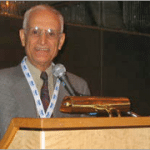The man behind IIBCC: Prof. Al Moslemi

In memory of Professor Al Moslemi
On 12 August 2012, Professor Al Moslemi passed away peacefully at the age of 74.
Professor Al Moslemi, as many of you may know, began the IIBCC conference series in 1988. The conference was initiated in the belief that the technology of inorganic-bonded composites had a great deal of potential in meeting the needs of our society for alternative building and possibly industrial materials.
Early research to windows of opportunity
Prior to the start of the first conference, Prof. Moslemi’s research focused mostly on wood particle and fiber composites. These composites had the attraction of using low grade wood and mill residues in manufacturing products such as particle board and medium and high density fiber boards. Organic resins such as urea formaldehyde and phenol formaldehyde, for example, were and continue to be used as binders for these products. Those industries have now become substantial worldwide.
In the search for alternative binders (or really matrices), he and his graduate students began to experiment with inorganic materials, such as Portland cement and gypsum. Actually, Prof. Moslemi’s exposure to inorganic-bonded composites began in the early 1960s. At that time, as a graduate student at Michigan State University in the US, he worked the summers in a small research lab at Elmendorf Research, Inc. located in California. A visionary laboratory manager by the name of Thomas Vaughn introduced Prof. Moslemi to the possibility of binding wood strands with Portland cement. In those days, lacking the information that we have today, there were some significant challenges to overcome. Many problems associated with wood-cement compatibility, for example, were encountered that required a basic understanding of the chemical reactions between the wood particles and the inorganic matrix. Once more knowledge was gained on these chemical interactions, windows of opportunity began to open. Good wood-cement bonding was, for example, combined with strand orientation (wood strands of about 25-30 mm long and 6-10mm wide of certain species). Exceptionally strong boards could thus be produced.
From local to global – the birth of the conference
The work on inorganic-bonded composites continued after Prof. Moslemi began his university career. By 1988, a few colleagues and Prof. Moslemi were working on the concept but never had the opportunity to gather in a meeting to share information. This is when Prof. Moslemi initiated the first conference expecting a very small group of mostly researchers and graduate students. To his surprise, some 160 participants from several parts of the world arrived at the University of Idaho campus where Prof. Moslemi worked. Having witnessed this unexpected interest, the decision was made to begin a continuing series of such conferences once every two years.
Continuation of the IIBCC
All the earliest conferences were organized by Prof Moslemi himself. However, he became ill in 2005 and passed on the job as organizer with the Sao Paulo conference to colleagues who had been involved with previous conferences. The need to continue with the conference and the burden of organizing it having become more demanding, resulted in the formation of the Technical Committee in 2008. So today, it is the IIBCC Committee that is continuing to provide the leadership to carry on the IIBCC series. We are confident that with the help of our colleagues, the IIBCC will continue to organize international gatherings that have been very helpful to advance the technologies and markets for fiber cement and related composites. With the increasing need to deal with recycled and other fiber resources and the need for construction materials, IIBCC will continue to be the pre-eminent forum where representatives from nations around the world gather to learn and make business and scientific contacts.
